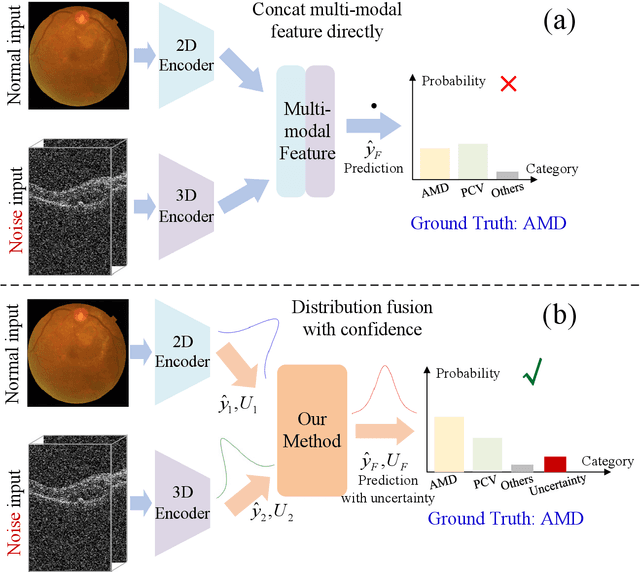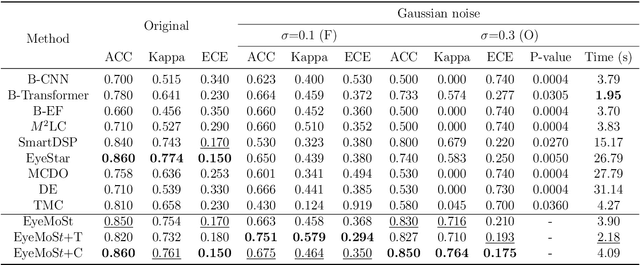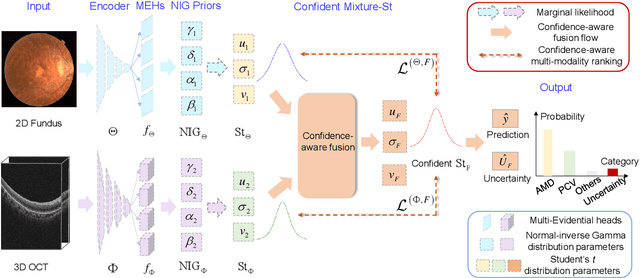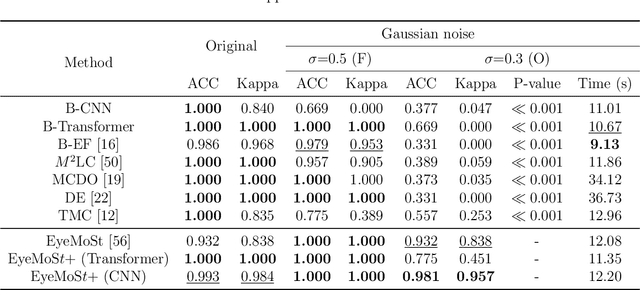Zongbo Han
DOTA: Distributional Test-Time Adaptation of Vision-Language Models
Sep 28, 2024



Abstract:Vision-language foundation models (e.g., CLIP) have shown remarkable performance across a wide range of tasks. However, deploying these models may be unreliable when significant distribution gaps exist between the training and test data. The training-free test-time dynamic adapter (TDA) is a promising approach to address this issue by storing representative test samples to guide the classification of subsequent ones. However, TDA only naively maintains a limited number of reference samples in the cache, leading to severe test-time catastrophic forgetting when the cache is updated by dropping samples. In this paper, we propose a simple yet effective method for DistributiOnal Test-time Adaptation (Dota). Instead of naively memorizing representative test samples, Dota continually estimates the distributions of test samples, allowing the model to continually adapt to the deployment environment. The test-time posterior probabilities are then computed using the estimated distributions based on Bayes' theorem for adaptation purposes. To further enhance the adaptability on the uncertain samples, we introduce a new human-in-the-loop paradigm which identifies uncertain samples, collects human-feedback, and incorporates it into the Dota framework. Extensive experiments validate that Dota enables CLIP to continually learn, resulting in a significant improvement compared to current state-of-the-art methods.
Confidence-aware multi-modality learning for eye disease screening
May 28, 2024



Abstract:Multi-modal ophthalmic image classification plays a key role in diagnosing eye diseases, as it integrates information from different sources to complement their respective performances. However, recent improvements have mainly focused on accuracy, often neglecting the importance of confidence and robustness in predictions for diverse modalities. In this study, we propose a novel multi-modality evidential fusion pipeline for eye disease screening. It provides a measure of confidence for each modality and elegantly integrates the multi-modality information using a multi-distribution fusion perspective. Specifically, our method first utilizes normal inverse gamma prior distributions over pre-trained models to learn both aleatoric and epistemic uncertainty for uni-modality. Then, the normal inverse gamma distribution is analyzed as the Student's t distribution. Furthermore, within a confidence-aware fusion framework, we propose a mixture of Student's t distributions to effectively integrate different modalities, imparting the model with heavy-tailed properties and enhancing its robustness and reliability. More importantly, the confidence-aware multi-modality ranking regularization term induces the model to more reasonably rank the noisy single-modal and fused-modal confidence, leading to improved reliability and accuracy. Experimental results on both public and internal datasets demonstrate that our model excels in robustness, particularly in challenging scenarios involving Gaussian noise and modality missing conditions. Moreover, our model exhibits strong generalization capabilities to out-of-distribution data, underscoring its potential as a promising solution for multimodal eye disease screening.
Hallucination of Multimodal Large Language Models: A Survey
Apr 29, 2024



Abstract:This survey presents a comprehensive analysis of the phenomenon of hallucination in multimodal large language models (MLLMs), also known as Large Vision-Language Models (LVLMs), which have demonstrated significant advancements and remarkable abilities in multimodal tasks. Despite these promising developments, MLLMs often generate outputs that are inconsistent with the visual content, a challenge known as hallucination, which poses substantial obstacles to their practical deployment and raises concerns regarding their reliability in real-world applications. This problem has attracted increasing attention, prompting efforts to detect and mitigate such inaccuracies. We review recent advances in identifying, evaluating, and mitigating these hallucinations, offering a detailed overview of the underlying causes, evaluation benchmarks, metrics, and strategies developed to address this issue. Additionally, we analyze the current challenges and limitations, formulating open questions that delineate potential pathways for future research. By drawing the granular classification and landscapes of hallucination causes, evaluation benchmarks, and mitigation methods, this survey aims to deepen the understanding of hallucinations in MLLMs and inspire further advancements in the field. Through our thorough and in-depth review, we contribute to the ongoing dialogue on enhancing the robustness and reliability of MLLMs, providing valuable insights and resources for researchers and practitioners alike. Resources are available at: https://github.com/showlab/Awesome-MLLM-Hallucination.
Multimodal Fusion on Low-quality Data: A Comprehensive Survey
Apr 27, 2024



Abstract:Multimodal fusion focuses on integrating information from multiple modalities with the goal of more accurate prediction, which has achieved remarkable progress in a wide range of scenarios, including autonomous driving and medical diagnosis. However, the reliability of multimodal fusion remains largely unexplored especially under low-quality data settings. This paper surveys the common challenges and recent advances of multimodal fusion in the wild and presents them in a comprehensive taxonomy. From a data-centric view, we identify four main challenges that are faced by multimodal fusion on low-quality data, namely (1) noisy multimodal data that are contaminated with heterogeneous noises, (2) incomplete multimodal data that some modalities are missing, (3) imbalanced multimodal data that the qualities or properties of different modalities are significantly different and (4) quality-varying multimodal data that the quality of each modality dynamically changes with respect to different samples. This new taxonomy will enable researchers to understand the state of the field and identify several potential directions. We also provide discussion for the open problems in this field together with interesting future research directions.
Selective Learning: Towards Robust Calibration with Dynamic Regularization
Feb 13, 2024



Abstract:Miscalibration in deep learning refers to there is a discrepancy between the predicted confidence and performance. This problem usually arises due to the overfitting problem, which is characterized by learning everything presented in the training set, resulting in overconfident predictions during testing. Existing methods typically address overfitting and mitigate the miscalibration by adding a maximum-entropy regularizer to the objective function. The objective can be understood as seeking a model that fits the ground-truth labels by increasing the confidence while also maximizing the entropy of predicted probabilities by decreasing the confidence. However, previous methods lack clear guidance on confidence adjustment, leading to conflicting objectives (increasing but also decreasing confidence). Therefore, we introduce a method called Dynamic Regularization (DReg), which aims to learn what should be learned during training thereby circumventing the confidence adjusting trade-off. At a high level, DReg aims to obtain a more reliable model capable of acknowledging what it knows and does not know. Specifically, DReg effectively fits the labels for in-distribution samples (samples that should be learned) while applying regularization dynamically to samples beyond model capabilities (e.g., outliers), thereby obtaining a robust calibrated model especially on the samples beyond model capabilities. Both theoretical and empirical analyses sufficiently demonstrate the superiority of DReg compared with previous methods.
Skip : A Simple Method to Reduce Hallucination in Large Vision-Language Models
Feb 12, 2024Abstract:Recent advancements in large vision-language models (LVLMs) have demonstrated impressive capability in visual information understanding with human language. Despite these advances, LVLMs still face challenges with multimodal hallucination, such as generating text descriptions of objects that are not present in the visual information. However, the underlying fundamental reasons of multimodal hallucinations remain poorly explored. In this paper, we propose a new perspective, suggesting that the inherent biases in LVLMs might be a key factor in hallucinations. Specifically, we systematically identify a semantic shift bias related to paragraph breaks (\n\n), where the content before and after '\n\n' in the training data frequently exhibit significant semantic changes. This pattern leads the model to infer that the contents following '\n\n' should be obviously different from the preceding contents with less hallucinatory descriptions, thereby increasing the probability of hallucinatory descriptions subsequent to the '\n\n'. We have validated this hypothesis on multiple publicly available LVLMs. Besides, we find that deliberately inserting '\n\n' at the generated description can induce more hallucinations. A simple method is proposed to effectively mitigate the hallucination of LVLMs by skipping the output of '\n'.
ID-like Prompt Learning for Few-Shot Out-of-Distribution Detection
Nov 28, 2023Abstract:Out-of-distribution (OOD) detection methods often exploit auxiliary outliers to train model identifying OOD samples, especially discovering challenging outliers from auxiliary outliers dataset to improve OOD detection. However, they may still face limitations in effectively distinguishing between the most challenging OOD samples that are much like in-distribution (ID) data, i.e., ID-like samples. To this end, we propose a novel OOD detection framework that discovers ID-like outliers using CLIP from the vicinity space of the ID samples, thus helping to identify these most challenging OOD samples. Then a prompt learning framework is proposed that utilizes the identified ID-like outliers to further leverage the capabilities of CLIP for OOD detection. Benefiting from the powerful CLIP, we only need a small number of ID samples to learn the prompts of the model without exposing other auxiliary outlier datasets. By focusing on the most challenging ID-like OOD samples and elegantly exploiting the capabilities of CLIP, our method achieves superior few-shot learning performance on various real-world image datasets (e.g., in 4-shot OOD detection on the ImageNet-1k dataset, our method reduces the average FPR95 by 12.16% and improves the average AUROC by 2.76%, compared to state-of-the-art methods).
Semantic Equivariant Mixup
Aug 12, 2023Abstract:Mixup is a well-established data augmentation technique, which can extend the training distribution and regularize the neural networks by creating ''mixed'' samples based on the label-equivariance assumption, i.e., a proportional mixup of the input data results in the corresponding labels being mixed in the same proportion. However, previous mixup variants may fail to exploit the label-independent information in mixed samples during training, which usually contains richer semantic information. To further release the power of mixup, we first improve the previous label-equivariance assumption by the semantic-equivariance assumption, which states that the proportional mixup of the input data should lead to the corresponding representation being mixed in the same proportion. Then a generic mixup regularization at the representation level is proposed, which can further regularize the model with the semantic information in mixed samples. At a high level, the proposed semantic equivariant mixup (sem) encourages the structure of the input data to be preserved in the representation space, i.e., the change of input will result in the obtained representation information changing in the same way. Different from previous mixup variants, which tend to over-focus on the label-related information, the proposed method aims to preserve richer semantic information in the input with semantic-equivariance assumption, thereby improving the robustness of the model against distribution shifts. We conduct extensive empirical studies and qualitative analyzes to demonstrate the effectiveness of our proposed method. The code of the manuscript is in the supplement.
Exploring and Exploiting Uncertainty for Incomplete Multi-View Classification
Apr 11, 2023Abstract:Classifying incomplete multi-view data is inevitable since arbitrary view missing widely exists in real-world applications. Although great progress has been achieved, existing incomplete multi-view methods are still difficult to obtain a trustworthy prediction due to the relatively high uncertainty nature of missing views. First, the missing view is of high uncertainty, and thus it is not reasonable to provide a single deterministic imputation. Second, the quality of the imputed data itself is of high uncertainty. To explore and exploit the uncertainty, we propose an Uncertainty-induced Incomplete Multi-View Data Classification (UIMC) model to classify the incomplete multi-view data under a stable and reliable framework. We construct a distribution and sample multiple times to characterize the uncertainty of missing views, and adaptively utilize them according to the sampling quality. Accordingly, the proposed method realizes more perceivable imputation and controllable fusion. Specifically, we model each missing data with a distribution conditioning on the available views and thus introducing uncertainty. Then an evidence-based fusion strategy is employed to guarantee the trustworthy integration of the imputed views. Extensive experiments are conducted on multiple benchmark data sets and our method establishes a state-of-the-art performance in terms of both performance and trustworthiness.
Reweighted Mixup for Subpopulation Shift
Apr 09, 2023Abstract:Subpopulation shift exists widely in many real-world applications, which refers to the training and test distributions that contain the same subpopulation groups but with different subpopulation proportions. Ignoring subpopulation shifts may lead to significant performance degradation and fairness concerns. Importance reweighting is a classical and effective way to handle the subpopulation shift. However, recent studies have recognized that most of these approaches fail to improve the performance especially when applied to over-parameterized neural networks which are capable of fitting any training samples. In this work, we propose a simple yet practical framework, called reweighted mixup (RMIX), to mitigate the overfitting issue in over-parameterized models by conducting importance weighting on the ''mixed'' samples. Benefiting from leveraging reweighting in mixup, RMIX allows the model to explore the vicinal space of minority samples more, thereby obtaining more robust model against subpopulation shift. When the subpopulation memberships are unknown, the training-trajectories-based uncertainty estimation is equipped in the proposed RMIX to flexibly characterize the subpopulation distribution. We also provide insightful theoretical analysis to verify that RMIX achieves better generalization bounds over prior works. Further, we conduct extensive empirical studies across a wide range of tasks to validate the effectiveness of the proposed method.
 Add to Chrome
Add to Chrome Add to Firefox
Add to Firefox Add to Edge
Add to Edge